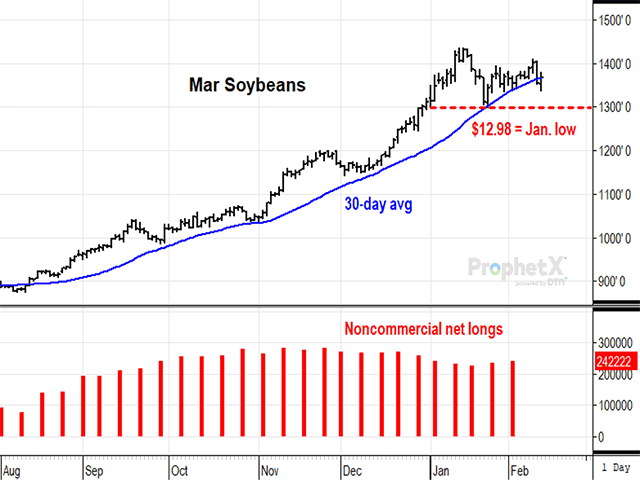Todd's Take
Was Wednesday's Soybean Sell-Off a Bluff?
Less than a week after writing about GameStop, the grain markets took another unexpected turn south this week after USDA lowered its estimate of U.S. ending corn stocks to 1.50 billion bushels (bb). The estimate was higher than expected and was surprising after the agency just reported 293 million bushels (mb) of export sales the week ended Jan. 28, most of which were for China.
Oddly, USDA raised China's corn import estimate by 256 mb to 945 mb or 24.0 million metric tons (mmt), but only raised the U.S. corn export estimate by 50 mb. Judging by USDA's lower corn demand estimates for Europe, Japan and South Korea, USDA apparently felt the loss of business in those countries was enough to limit expectations for U.S. corn exports to 2.60 bb.
The corn market took the report's news rather hard as the March contract fell from a peak of $5.74 1/4 minutes before the report was released to $5.41 by Thursday's close (Feb. 11). The funny thing was that technically speaking, March soybeans took the news even harder.
March soybeans actually survived Tuesday's report with a 14-cent gain, closing at $14.01 3/4. USDA's new U.S. ending soybeans stocks estimate of 120 mb for 2020-21 was in line with expectations. The estimate also put soybeans' ending stocks-to-use ratio at 2.6%, matching the lowest such ratio in modern history.
If we want to go a little further, Thursday's Export Sales report showed U.S. soybean export commitments at 2.185 bb, only 65 mb away from USDA's export estimate of 2.250 bb. The way sales have been going lately, that's about two weeks' worth, but there is over six months left in the 2020-21 season.
P[L1] D[0x0] M[300x250] OOP[F] ADUNIT[] T[]
For those concerned about China canceling previous sales, it's not likely this year. First, prices have been rallying so there is no incentive to cancel previous sales in 2020-21. Secondly, China has already shipped 94% of its known soybean purchases and continues to act desperate to secure supplies.
Granted, Brazil is about to harvest a record soybean crop -- if it ever stops raining in the central and northern regions. Both USDA and Brazil's crop agency, Conab, agree the crop will be near 4.90 bb.
That should keep China fed for a while, but what nobody knows is for how long. It was just a year ago Brazil harvested a record soybean crop of 4.63 bb, thought to be bearish. It was in early July when we started noticing Brazil's soybean prices were already near their highs of 2019.
China was such an aggressive buyer of soybeans that Brazil's record crop lasted less than six months before China started knocking on the door of the U.S. looking for more. On Tuesday, Feb. 9, USDA estimated Brazil's soybean supplies just finished the old-crop season with 57 mb on hand. After harvesting this new record crop, USDA estimates Brazil will finish the new season with 59 mb of soybeans. China's appetite is big.
Last year at this time, the U.S. was estimating a 425 mb soybean surplus that grew to 610 mb in the August World Agricultural Supply and Demand Estimates (WASDE) report. Now, USDA is estimating a 120 mb surplus, which depends on us ignoring export sales. There is no room on the balance sheet for China to come knocking for soybeans any time before fall harvest in 2021, and that doesn't even take into account the possibility of adverse U.S. weather.
So, perhaps you shared my confusion Wednesday (Feb. 10), watching March soybeans drop 47 3/4 cents to $13.54, the first close below the 30-day average since mid-August when the rally first began in earnest. Technically, prices left behind a lower high on the day of the report. For the 242,222 noncommercial net-longs in soybeans CFTC reported as of Feb. 2, the sell-off could have looked enticing to join. Large speculative crowds spook easily and probably did.
The difficult thing is that our understanding of the fundamentals is never perfect, and I am keenly aware that surprises can happen in markets and in life. When it comes to markets and the future in general, I'm never 100% confident about anything, but as far as I can tell, Wednesday's selling was a bluff.
Even if Brazil's rain went away and they harvested that record soybean crop next week, it remains difficult to envision a scenario where U.S. soybeans aren't incredibly tight this summer. The most bearish risk I currently see is in the flighty noncommercial crowd. If, for some reason, March soybeans were to fall below the January low of $12.98, there would be another reason for liquidation to follow.
Todd Hultman can be reached at Todd.Hultman@dtn.com
Follow him on Twitter @ToddHultman1
(c) Copyright 2021 DTN, LLC. All rights reserved.




